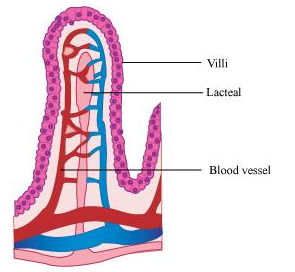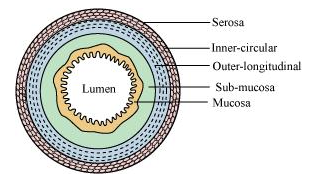Answer briefly:
(a) Why are villi present in the intestine and not in the stomach?
(b) How does pepsinogen change into its active form?
(c) What are the basic layers of the wall of alimentary canal?
(d) How does bile help in the digestion of fats?

(a) The mucosal wall of the small intestine forms millions of tiny finger-like projections known as villi. These villi increase the surface area for more efficient food absorption.
Within these villi, there are numerous blood vessels that absorb the digested products of proteins and carbohydrates, carrying them to the blood stream. The villi also contain lymph vessels for absorbing the products of fat-digestion. From the blood stream, the absorbed food is finally delivered to each and every cell of the body.
The mucosal walls of the stomach form irregular folds known as rugae. These help increase the surface area to volume ratio of the expanding stomach.
(b) Pepsinogen is a precursor of pepsin stored in the stomach walls. It is converted into pepsin by hydrochloric acid. Pepsin is the activated in the form of pepsinogen.
Pepsinogen ![]() Pepsin + Inactive peptide
Pepsin + Inactive peptide
(Inactive) (Active)
(c) The walls of the alimentary canal are made up of four layers. These are as follows:

(i) Serosa is the outermost layer of the human alimentary canal. It is made up of a thin layer of secretory epithelial cells, with some connective tissues underneath.
(ii) Muscularis is a thin layer of smooth muscles arranged into an outer longitudinal layer and an inner circular layer.
(iii) Sub-mucosa is a layer of loose connective tissues, containing nerves, blood, and lymph vessels. It supports the mucosa.
(iv) Mucosa is the innermost lining of the lumen of the alimentary canal. It is mainly involved in absorption and secretion.
(d) Bile is a digestive juice secreted by the liver and stored in the gall bladder. Bile juice has bile salts such as bilirubin and biliverdin. These break down large fat globules into smaller globules so that the pancreatic enzymes can easily act on them. This process is known as emulsification of fats. Bile juice also makes the medium alkaline and activates lipase.
Click here to get exam-ready with eSaral
For making your preparation journey smoother of JEE, NEET and Class 8 to 10, grab our app now.
